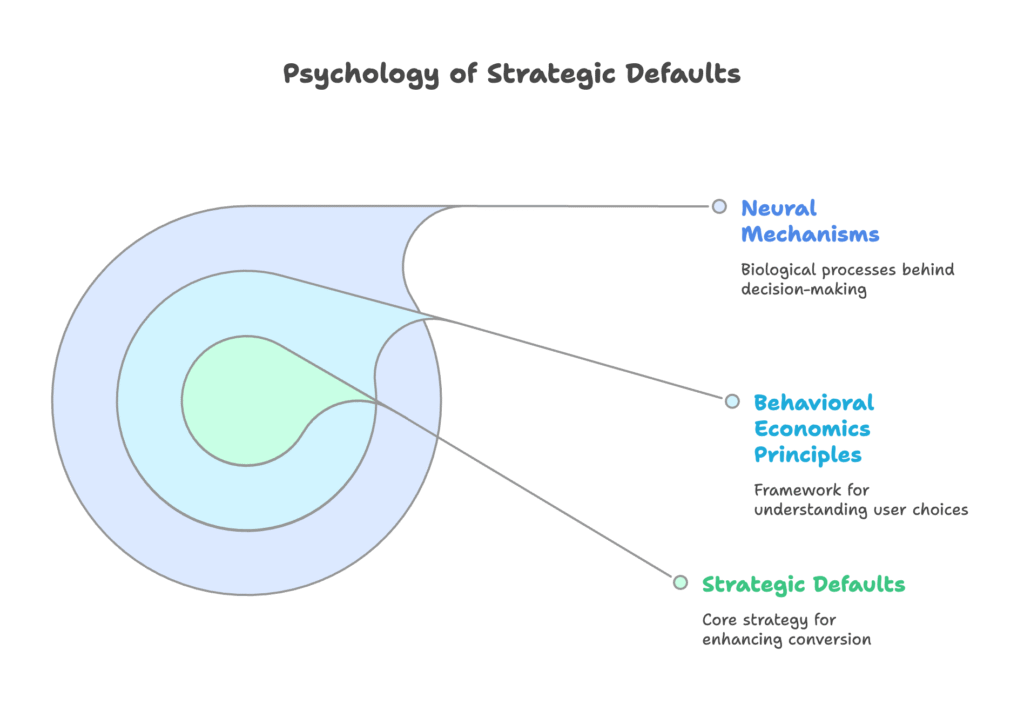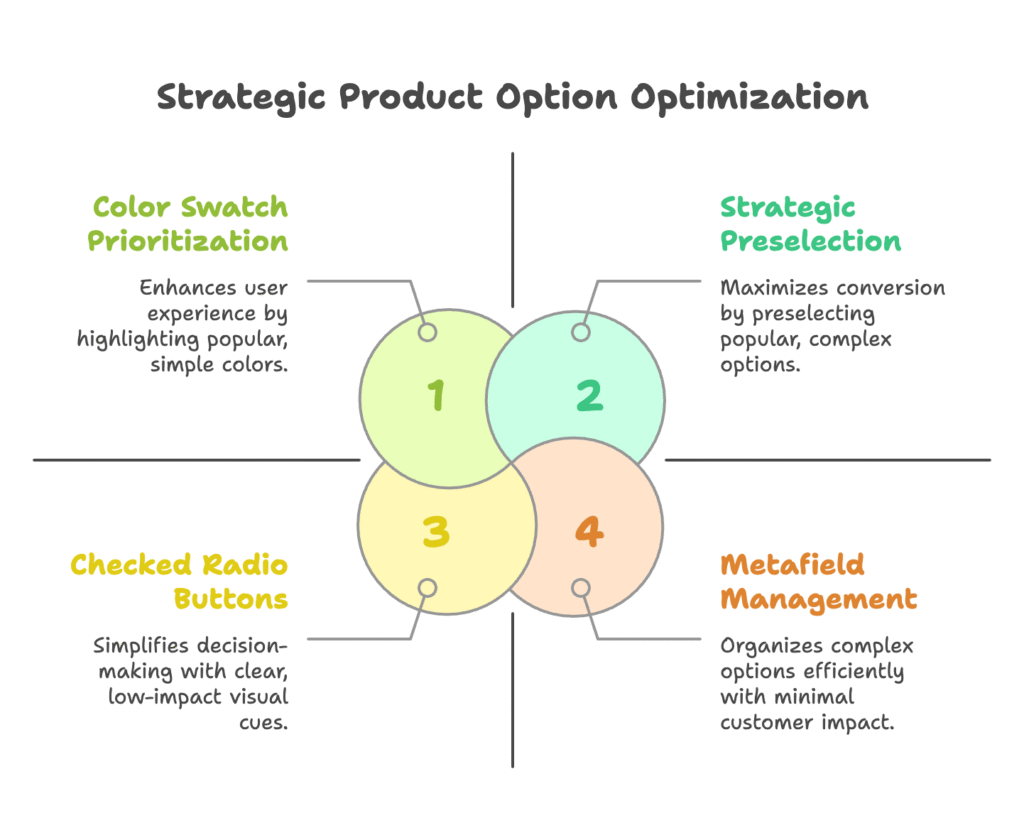Whether you’re struggling with abandoned carts or wondering why customers aren’t selecting your most profitable product variants, understanding how to leverage defaults could be the game-changer your Shopify store needs. The psychology behind defaults is fascinating – did you know that a staggering 80% of shoppers simply stick with pre-selected options?
In this article, you’ll discover how to ethically harness behavioral economics principles to optimize your product options and checkout process. You’ll learn practical strategies that real Shopify merchants have used to boost average order values by 19% and reduce cart abandonment by 27%. Ready to transform those small default tweaks into significant revenue gains? Let’s dive in!
Theoretical Foundations of Strategic Defaults
Before we jump into implementation tactics, let’s understand the powerful psychology that makes defaults so influential in the shopping experience. These foundational concepts will help you appreciate why seemingly small default choices can dramatically impact your conversion rates.

Behavioral Economics Principles
- Default Bias: Research shows an astonishing 80% of users simply stick with pre-selected options. This isn’t laziness—it’s how our brains are wired! When faced with multiple choices, we often interpret defaults as implicit recommendations or the “normal” choice.
- Cognitive Load Reduction: Every decision requires mental energy. By setting smart defaults, you’re reducing the number of active decisions your customers need to make. This simplification can increase conversion rates by up to 23% by preventing decision fatigue.
- Endowment Effect: Here’s something fascinating—users actually value default-selected items about 40% higher than non-selected alternatives. Once something is “theirs” (even just as a default selection), people become more attached to it and are less likely to switch.
Neural Mechanisms
Let’s demystify what’s happening in your customers’ brains when they encounter defaults:
- Your prefrontal cortex—the brain’s decision-making center—actively conserves energy when possible. Defaults provide a low-energy path forward, making them naturally appealing.
- When we accept a default option, our brains release a small dose of dopamine, giving us a satisfaction hit from “completing” an action without much effort.
- The amygdala, which processes potential threats, stays calmer when we follow familiar pathways like defaults. Making active changes triggers a mild stress response that our brains prefer to avoid.
Understanding these mechanisms isn’t just interesting—it’s practical! Now that we know why defaults work so powerfully, let’s explore how to implement them throughout your product pages. Are you ready to transform this psychology into actual sales strategies? Let’s see how to apply these principles to your product options!
Product Options Strategy Framework
With our psychological foundation in place, it’s time to roll up our sleeves and implement strategic defaults across your product pages. This section will give you practical tactics to optimize variant selection and visual cues that subtly guide customers toward your preferred options.

Variant Default Optimization
Core Principles:
- Option Limitation: The sweet spot for product variants is between 3-7 options. Beyond this, customer overwhelm increases and conversion rates typically drop. If you absolutely need more variants, consider grouping them into logical categories.
- Strategic Preselection: Always preselect your best-selling combinations as defaults. This leverages social proof (what others are buying) while typically matching what new customers are most likely to want.
- Metafield Management: For products with complex configurations, use Shopify metafields to organize and prioritize default options, keeping your product page clean while maintaining sophisticated variant management.
Implementation Tactics:
- Color Swatch Prioritization: Arrange color swatches based on popularity, with bestsellers first. Consider using RGB frequency analysis to determine which colors should be preselected based on seasonal trends or your target demographic’s preferences.
- Size Preselection: Use geo-location data to preselect the most common size for visitors from specific regions. For example, preselect medium for North American visitors and small for Asian visitors based on regional size distribution data.
- “Recommended Package” Bundles: Create default bundles that include your core product plus complementary items with higher margins. This increases average order value while simplifying the customer’s decision process.
Visual Default Cues
Design Elements:
- Checked Radio Buttons: Make your default selections visually obvious with pre-checked radio buttons or highlighted options that stand out from alternatives.
- “Most Popular” Badge Placement: Position “Most Popular” or “Best Seller” badges aligned with the F-pattern scanning behavior (top-left to right, then down) to catch attention at natural eye movement pause points.
- Progressive Disclosure: Hide advanced options behind a “More Options” toggle to prevent overwhelming customers with choices they rarely need, while keeping your default selections front and center.
These product page strategies create a path of least resistance toward your preferred options while still giving customers the freedom to make different choices if they prefer. But what happens after they’ve selected their product? The checkout process offers even more powerful opportunities for strategic defaults. Let’s explore how to optimize that critical final step in the customer journey!
Checkout Process Optimization
The checkout is where intentions transform into sales—or abandoned carts. Strategic defaults here can dramatically reduce friction and increase completion rates. Let’s explore how to implement smart defaults throughout the checkout process to guide customers smoothly toward purchase.
Field Default Strategy
Every field in your checkout represents a potential stopping point. Here’s how to optimize each:
- Shipping Address: Implementing geolocation auto-complete can increase conversion by a remarkable 35%. The system can pre-fill city and country fields based on IP address, reducing the typing burden on customers.
- Payment Method: For returning customers, defaulting to their last-used payment method increases repeat purchases by approximately 28%. For new customers, default to the most popular payment method in their region.
- Newsletter Signup: While opt-out (pre-checked) signup boxes may capture more emails initially, they tend to increase list fatigue by 41% due to lower engagement. Consider a middle-ground approach with clear value proposition rather than forcing opt-ins.
- Shipping Method: Default to the option that balances customer satisfaction with your margins. For orders above a certain threshold, automatically select free shipping to increase perceived value.
Smart Default Hierarchy
Not all defaults are created equal. When determining which options to preselect, follow this priority order:
- Customer Historical Preferences: Always prioritize what the customer has chosen before. This creates a personalized experience that respects their established preferences.
- Geographic Relevance: When customer history isn’t available, default to options that make sense for their location (shipping methods, sizes, payment options popular in their region).
- Inventory Availability: Default to variants with healthy stock levels to prevent the frustration of selecting an option only to find it’s unavailable.
- Profit Margin Optimization: When all other factors are equal, default to options that maximize your profit while still providing excellent customer value.
Implementing these checkout strategies can dramatically streamline the purchase process, but there’s an important balance to strike. How do you leverage defaults effectively while maintaining customer trust? That’s where ethical implementation becomes crucial. Let’s explore how to boost conversions with defaults while keeping your brand integrity intact!
Ethical Implementation Guidelines
The power of defaults comes with responsibility. In this section, we’ll explore how to implement strategic defaults while maintaining customer trust and complying with regulations. These ethical guidelines ensure your conversion optimization tactics create satisfied customers rather than feeling manipulative.
Dark Pattern Avoidance
Transparency Requirements:
- Visual Distinction: Make preselected options visually obvious through highlighting, bold text, or clear indicators. Customers should never feel tricked or confused about what’s been preselected for them.
- Easy Reset Options: Always provide a simple “reset to default” or “clear all selections” option that allows customers to start fresh if they want to reconsider their choices.
- Honest Labeling: If you mark an option as “Recommended” or “Most Popular,” ensure it genuinely is—not just your highest margin option. Misleading labels erode trust quickly.
Legal Compliance:
- GDPR Standards: Remember that in many jurisdictions, particularly under GDPR in Europe, opt-in consent must be active and explicit for data collection. Pre-checked consent boxes often violate these regulations.
- Truth in Advertising: Claims like “recommended by experts” or “customer favorite” must be substantiated by actual data to avoid potential legal issues and maintain customer trust.
- Accessibility Compliance: Ensure your default selections are accessible to all users, including those using screen readers or other assistive technologies.
Cognitive Protection
Protect your customers’ cognitive resources with these design considerations:
- Mobile-First Sizing: Ensure all clickable defaults have touch targets of at least 44px on mobile devices, making it easy for customers to both select and change options without frustration.
- Dyslexia-Friendly Labeling: Use clear, sans-serif fonts and high contrast for option labels to ensure all customers can easily understand their choices.
- Session-Based Default Resets: If a customer spends significant time considering options but doesn’t purchase, consider refreshing defaults on their next visit rather than potentially creating frustration by preserving all their previous selections.
Ethical implementation isn’t just about avoiding trouble—it builds the trust that drives long-term customer loyalty. But does all this theory actually work in practice? Let’s look at real-world success stories that demonstrate just how powerful strategic defaults can be when implemented thoughtfully.
Case Studies & Results
Theory is valuable, but results speak volumes. In this section, we’ll examine real-world examples of Shopify stores that have successfully implemented strategic defaults and the impressive results they’ve achieved. These case studies provide practical inspiration you can adapt for your own store.
Fashion Retailer: 19% AOV Increase
A mid-sized fashion retailer implemented two key default strategies with remarkable results:
- Tactic: They preselected premium shipping as the default option for orders over $75, with a subtle message highlighting that “Most customers choose expedited shipping for orders this size.” Additionally, they implemented size chart defaults based on previous purchase history.
- Result: An impressive 63% of customers maintained the suggested premium shipping option, driving a 19% increase in average order value within just six weeks of implementation.
- Key Insight: The retailer found that framing the shipping upgrade as a normal customer choice (social proof) rather than an upsell significantly increased acceptance rates compared to their previous approach.
Electronics Store: 32% Faster Checkout
An electronics retailer focused on streamlining their checkout process:
- Strategy: They implemented address auto-complete functionality based on postal codes, coupled with stored payment defaults for returning customers. They also reduced their checkout form fields from 14 to just 7 required fields.
- Impact: Checkout completion time decreased by 32%, and more importantly, cart abandonment rates dropped by 27% in the first month after implementation.
- Key Insight: Their analysis revealed that each additional field in the checkout process increased abandonment rates by approximately 3.4%. The most significant improvements came from simplifying shipping options to three clearly differentiated choices with the middle option preselected.
Subscription Service: 41% Retention Boost
A beauty subscription box service transformed their retention rates with default optimization:
- Approach: They shifted from requiring customers to actively choose product preferences to offering a curated “Recommended for You” default box based on initial quiz results, with easy options to modify selections.
- Results: Not only did initial sign-ups increase by 24%, but subscription retention after three months improved by a remarkable 41%.
- Neurometric Data: Their user experience testing found a 22% reduction in decision fatigue markers, as measured by EEG testing with a sample customer group. Customers reported higher satisfaction despite making fewer active choices.
These success stories demonstrate the real-world impact of thoughtfully implemented defaults across different Shopify store types. But what’s on the horizon for default optimization? Let’s peek into the future to see how emerging technologies will transform how we use defaults to enhance the shopping experience!
Future of Default Engineering
The world of e-commerce and default optimization continues to evolve rapidly. In this final section, we’ll explore emerging technologies and predictive models that will shape how Shopify stores implement defaults in the coming years. Understanding these trends will help you stay ahead of the curve.
Emerging Technologies
- AI-Personalized Defaults: Machine learning algorithms are increasingly capable of predicting individual preferences with remarkable accuracy. Future Shopify stores will likely offer hyper-personalized default options based not just on past purchases but on browsing behavior, time spent viewing products, and even cursor movement patterns.
- Voice-Activated Default Selection: As voice shopping continues to grow, defaults will become even more important. Voice interfaces typically offer fewer options and rely heavily on suggested defaults that match the customer’s likely preferences.
- Blockchain-Verified Defaults: For high-end products or subscription services, blockchain technology may soon enable transparent algorithm auditing, allowing customers to understand exactly why certain defaults were recommended to them, building trust in the system.
Predictive Models
- Lifetime Value Default Scoring (LVD): Advanced analytics will increasingly focus on optimizing defaults not just for immediate conversion but for maximum customer lifetime value. This approach weighs default selections based on their likelihood to create loyal, long-term customers rather than just short-term sales.
- Context-Aware Preselection Engines: Future systems will likely adjust defaults based on contextual factors like time of day, weather in the customer’s location, recent news events, and even the device being used to browse your store.
- Emotional Response Optimization: As emotion-detection technology matures, defaults may eventually be optimized based on the emotional state of the customer, offering more customization options to frustrated users or streamlined defaults to those showing signs of decision fatigue.
These future developments will further enhance the effectiveness of strategic defaults while improving the customer experience. The key will be implementing these technologies thoughtfully, maintaining transparency and customer trust while leveraging increasingly sophisticated data analysis.
As we’ve seen throughout this article, strategic defaults are powerful tools for guiding customer behavior while simplifying the shopping experience. By understanding the psychological principles behind defaults, implementing thoughtful strategies across your product pages and checkout process, and maintaining ethical implementation standards, you can significantly boost your store’s conversion rates and customer satisfaction.
Remember: Looking to take your Shopify store’s conversion optimization to the next level? Growth Suite offers intelligent visitor behavior tracking and personalized, time-limited discount offers that complement strategic defaults perfectly. By implementing both approaches, you can create a seamless shopping experience that guides customers toward purchase while maintaining brand integrity.



